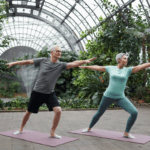Coming Soon: E-book about Kundalini Yoga - Sign up here to be among the first to get it!
Yoga, an ancient practice that has traversed through centuries, cultures, and continents, is celebrated for its holistic benefits—uniting mind, body, and spirit. Yet, as it has become more mainstream, the necessity for inclusivity within its practice has never been more paramount. Inclusivity in yoga means creating spaces where everyone, regardless of physical ability, age, gender, race, or socioeconomic status, feels welcomed and able to participate fully. This article aims to shed light on strategies for accessible yoga teaching, ensuring that yoga instructors and practitioners alike can foster environments where yoga truly is for everyone.

Understanding Inclusivity in Yoga
Inclusivity in yoga teaching means recognizing and addressing the diverse needs of students. It involves adapting teaching methods, communication, and class settings to ensure all participants can enjoy and benefit from yoga. This inclusivity extends to physical accessibility, cultural sensitivity, and affordability.
Adapting Yoga Spaces
Physical Environment
- Accessibility: Ensure your yoga space is accessible to individuals with mobility challenges, including those who use wheelchairs. This may involve selecting locations that are ADA (Americans with Disabilities Act) compliant, with ramps and spacious practice areas.
- Props and Equipment: Offer a variety of props—blocks, straps, chairs, bolsters, and blankets. Props can be instrumental in making poses more accessible and comfortable for a broader range of bodies and abilities.
Communication and Language
- Clear and Supportive Language: Use language that is welcoming and inclusive, avoiding assumptions about participants’ abilities. Instruction should be clear and offer variations for poses, accommodating different levels of flexibility, strength, and experience.
- Visual Aids and Demonstrations: Incorporate visual aids and demonstrations to cater to visual learners and those who may have hearing impairments.
Teaching Techniques for Inclusive Yoga
Modified Asanas
Offer modifications for traditional asanas to accommodate students with various needs. For example, a chair can be used to perform a modified Warrior pose for those who find standing difficult. Incorporating props like blocks can help in achieving poses like Triangle pose, making it accessible to those with limited flexibility.
Use of Props
Props such as blocks, straps, chairs, bolsters, and blankets are essential in adaptive yoga. They are used to support the body in different poses, making the poses accessible and comfortable for everyone. For example, a chair can be used to practice seated versions of standing poses, ensuring that those who cannot stand for long periods can still benefit from the practice.
Modified Poses
Instructors modify traditional yoga poses to accommodate various needs. This might mean breaking down poses into smaller, more manageable steps or creating entirely new poses that provide similar benefits without the same physical demands.
Focus on Breathwork and Meditation
Incorporate practices that emphasize breath control and meditation, which are accessible to most people regardless of physical ability. These practices are core to yoga and can be profoundly beneficial, reducing stress and improving mental health.
Adaptive Yoga Classes
Consider offering classes specifically designed for individuals with particular needs, such as yoga for seniors, prenatal yoga, or yoga for individuals with disabilities. These classes can address specific concerns and adaptations, providing a supportive community for participants.
Incorporating Mindfulness and Body Awareness
Adaptive yoga teaches mindfulness and body awareness, encouraging students to tune into their bodies and listen to their needs. This awareness can help prevent injury and promote a deeper connection to the self, enhancing the overall yoga experience.
Cultural Sensitivity and Affordability
Cultural Sensitivity: Be mindful of the cultural origins of yoga and respect its traditions and practices. Ensure that your teaching is respectful and inclusive of all cultural backgrounds.
Affordability: Offer sliding scale fees, donation-based classes, or free community classes to make yoga accessible to people of all socioeconomic backgrounds.
Examples and Studies
Recent studies highlight the positive impacts of inclusive yoga practices. A study published in the *Journal of Alternative and Complementary Medicine* found that adaptive yoga can significantly improve the quality of life for individuals with physical disabilities. Another study in the *International Journal of Yoga Therapy* showcases how yoga can be adapted for older adults, leading to improvements in mobility, balance, and mental well-being.
Implementing Inclusive Practices
Continuous Learning
Stay informed about best practices for accessible yoga by attending workshops, seminars, and training focused on inclusivity and adaptive yoga techniques.
Feedback and Adaptation
Encourage feedback from your students and be willing to adapt your teaching methods based on their needs and experiences. This ongoing dialogue is crucial for fostering an inclusive yoga environment.
Collaboration
Work with organizations and communities to reach individuals who may benefit most from accessible yoga practices but are least likely to have access to them. Collaborating with healthcare professionals, disability advocates, and community centers can broaden your impact.
Conclusion
Making yoga accessible and inclusive is not just about modifying poses; it’s about fostering an environment where every individual feels valued, respected, and empowered. By implementing the strategies outlined above, yoga teachers can lead the way in making the practice of yoga truly universal. As we continue to learn, adapt, and grow, the essence of yoga as a practice for all remains a guiding light.
In the journey towards inclusive yoga teaching, the ultimate goal is to create a space where yoga’s transformative power is accessible to everyone. Through awareness, adaptation, and advocacy, we can ensure that the spirit of yoga transcends all barriers, making the ancient practice a modern sanctuary for all.



